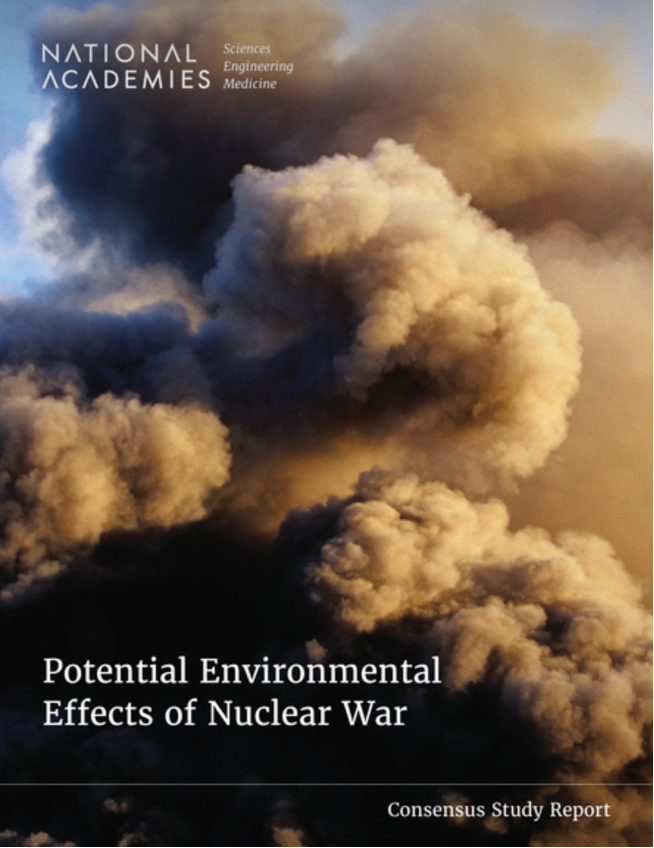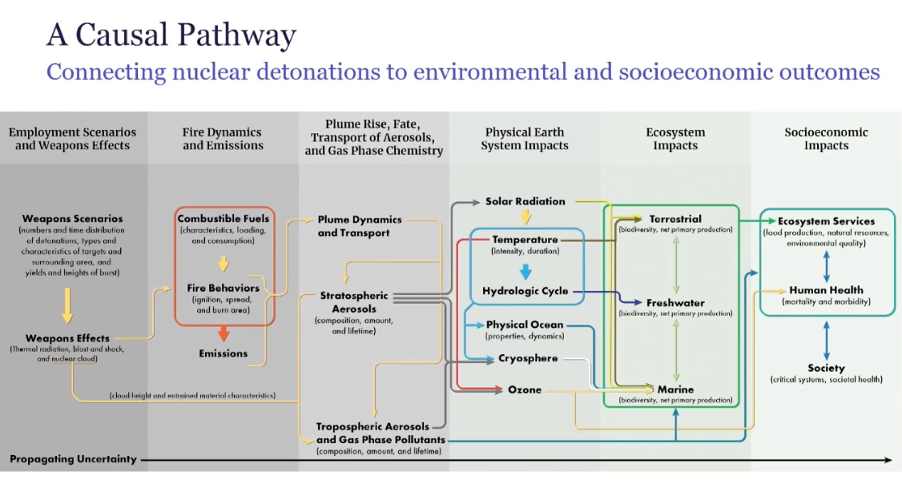New US NAS Report: How Nuclear War Would Cascade Through Society and Economy

New US National Academy of Sciences Report reveals the complex web of societal vulnerabilities that could amplify nuclear war’s devastating impact

TLDR/Summary
- The US National Academy of Sciences has just released a comprehensive report on the “Environmental Effects of Nuclear War”. This work extends analysis beyond physical damage to examine impacts on human social and economic systems.
- Chapter 7 reveals that nuclear war’s most severe consequences may come through cascading societal failures rather than direct blast effects, with global interconnections creating “societal teleconnections” that could spread impacts worldwide.
- Global crop yields could suffer 3–16% reductions from nuclear winter cooling, while marine fisheries could decline by 30–70%, threatening global food security.
- The report identifies fundamental gaps in our understanding of how complex human systems respond to nuclear shocks, calling for unprecedented interagency coordination and advanced modelling.
- While acknowledging massive uncertainties, the evidence suggests even regional nuclear conflicts could trigger global disruptions through interconnected trade, financial, and supply chain networks.
- Key recommendations call for coordinated US Government assessment, advanced predictive modelling, comprehensive research programmes, health system preparedness, and community resilience initiatives.
- We have previously made similar recommendations about the need for post-nuclear-war trade and supply modelling, the need for New Zealand to build resilience and how, and lessons from past volcanic winters.
A System of Systems Under Stress
The National Academy of Sciences’ (NAS) latest report on nuclear war represents a critical evolution in how we understand catastrophic risks. Unlike Cold War-era studies focused primarily on blast radius and fallout, this analysis treats nuclear conflict as a “system of systems” problem, where cascading failures through interconnected human networks may prove more devastating than the initial explosions. I watched with interest the 25 June webinar presentation by the NAS authors, which summarised the findings. Chapters deal in turn with:
- Nuclear weapon scenarios and weapon effects
- Fire dynamics
- Effects of plumes, aerosols, and chemistry
- Physical Earth system impacts
- Ecosystem impacts
- Societal and economic impacts
Although the report inexplicably omits study of the effects of radiation and radioactive fallout, as per their directive from the US Congress, particularly relevant is Chapter 7, which examines the societal and economic impacts of nuclear war.
This Chapter has much in common with our own NZCat Main Report from 2023 on New Zealand’s vulnerability and resilience options to Northern Hemisphere nuclear war (summarised in recent journalistic reporting here).
Chapter 7 provides a sobering assessment of how nuclear war would ripple through the complex web of modern civilisation. The findings reveal that while humanity has grown adept at modeling the physics of nuclear explosions, we remain dangerously ignorant about how human societies collapse and recover under such extreme stress.

When Food Systems Fail
The agricultural impacts alone paint a grim picture. The report concludes that nuclear winter effects from atmospheric soot could reduce global crop yields by 3–16%, with temperate regions above 30°N—including the United States, China, and Europe—facing the greatest impacts.
The cause of this precipitous drop in yield is the 5–12 teragrams (Tg) of soot that would be thrown high in the atmosphere, blocking the sun.
The large-scale scenario described in Section 2.2.2 could inject 5 to 12.5 Tg of submicron particles in the stratosphere (p.42).
These findings align our own reporting for New Zealand (NZCat Main Report), based on 10–30 Tg of soot, with even further reductions in yield due to cascading shortages of industrial agricultural inputs like imported fuel, fertiliser, seed, and agrichemicals.
Marine ecosystems would suffer as well. The NAS report projects 30% declines in global fisheries catches after a major nuclear conflict, potentially reaching 70% if fisheries are already overfished. These aren’t abstract statistics—they represent the potential collapse of food systems that sustain billions of people.
As the report notes:
Nuclear winter may be one of the most far-reaching public health crisis scenarios, with effects including threats to global food security. Secondary impacts would disrupt transport, food, water, trade, energy, finance, and communication to the detriment of public health efforts (p.169).
The Cascade Effect: When Everything is Connected
Perhaps most concerning is the report’s analysis of “societal teleconnections” (p.155), how disruptions cascade through today’s hyperconnected global systems. Historical examples demonstrate this vulnerability: oil crises, natural disasters, and regional conflicts have repeatedly triggered worldwide food price spikes and economic instability. Nevertheless, the report possibly understates these connection risks, given advancing research in global systemic risk, such as the interaction of algorithms and the potential for deleterious algorithmic collisions in unforeseen circumstances.
In a nuclear conflict scenario, these connections become transmission vectors for catastrophe. Trade networks, supply chains, and financial systems that normally distribute prosperity could instead spread economic collapse. The scale could surpass Covid-19 pandemic disruptions (p.169), with the added challenge that recovery infrastructure might itself be compromised. As we’ve written before, the world needs specific ‘resilience’ infrastructure to call on when business-as-usual has ceased functioning, not merely ‘resilient’ infrastructure.
The NAS report notes that the human toll extends far beyond immediate casualties. Direct health consequences include blast injuries, thermal burns, radiation exposure, and severe mental health trauma. Studies of atomic bomb survivors show increased suicide rates, PTSD, and intergenerational psychological effects that persist for decades. Mass displacement would overwhelm shelter, healthcare, food, and water provision, while psychological impacts could trigger panic, hoarding, and breakdown of civil order. Additionally the webinar panel was explicit that:
It’s difficult to understate the importance of the economic disruptions.
That said, the geographic particulars, and type and number of weapons employed, as well as the targets struck, will all interact to determine the effects of any particular nuclear conflict.

The Knowledge Gap Crisis
The report’s most troubling finding may be how little we actually know. As the authors acknowledge:
There is a fundamental lack of data, process understanding, and modelling capabilities that prevents researchers and analysts from quantitatively linking specific nuclear war scenarios to precise societal outcomes (p.152).
Current climate models “are not well suited for evaluating the consequences of sudden shocks such as nuclear war” as they focus on gradual changes rather than abrupt disruptions. We lack understanding of ecosystem recovery thresholds, low-dose radiation effects, complex human behavioural responses, and cascading infrastructure failures.
We have noted these shortcomings before and highlighted the need for modelling the potential cascading consequences to trade and supply chain of major catastrophes like nuclear war. Our paper ‘Resilience Reconsidered: The need for modelling resilience in food distribution and trade relations in post nuclear war recovery’, is forthcoming in a Special Issue on Polycrisis and Systemic Risk in the International Journal of Disaster Risk Science. You can read a preprint here.
Without understanding how societies collapse and recover, we cannot effectively prepare for or prevent these catastrophes.
Building Resilience in an Uncertain World
Despite massive uncertainties, the report doesn’t counsel despair. Community resilience, social capital, and preparedness can significantly influence outcomes. Strong governance, robust infrastructure, and social cohesion enable better recovery.
These are investments that benefit society whether or not nuclear war can be prevented. This finding echoes our own mention of a four capitals approach to building resilience to global catastrophic risk, see our report Aotearoa New Zealand, Global Catastrophe, and Resilience Options.
While the prevention of nuclear war must remain a high priority of all governments, countries not contributing to the nuclear arms race (like New Zealand) should consider improving their survival chances. The NAS report’s key recommendations around societal and economic consequences of nuclear war provide a roadmap for action:
- Interagency coordination: Major government agencies must develop coordinated assessments of how nuclear war would affect food, water, health, and economic systems.
- Advanced modelling: Investment in sophisticated capabilities that integrate climate, agricultural, and economic factors to help policymakers develop contingency plans.
- Comprehensive research: Transdisciplinary collaboration to understand climate impacts, ecosystem recovery, and community resilience.
- Health system preparedness: Strengthening hospital capacity, public health workforce, and strategic stockpiles.
- Community resilience: Research on how social inequities would influence nuclear impacts, with emphasis on local collaboration.
The evidence is strongest for direct agricultural and health impacts, moderate for broader economic disruptions based on historical precedents, and weakest for complex cascading social effects.
But even the moderate-confidence findings paint a picture of civilisational disruption that demands preparation, and preparing to survive nuclear war would benefit preparations for other major global catastrophes too.
Wider Global Context
This US NAS report joins a growing body of work examining the likely impacts of nuclear war, including:
- The UN’s recent call for nominations for a scientific panel being established to assess the impacts of nuclear war
- Upcoming WHO health impact studies
- Our own NZCat analysis of New Zealand’s vulnerability to Northern Hemisphere nuclear war.
Together, these efforts represent recognition that nuclear threats require serious, coordinated analysis and mitigation options.
As geopolitical tensions rise in 2025, the NAS report’s timing proves prescient. We face an era of increasing instability where nuclear risks intersect with other global catastrophic threats, such as pandemics, climate change, and technological disruption (eg, from artificial intelligence).
Finally, it is a shame that the NAS was so cautious in their assessment of the quality of evidence available. The report seemed to demand very high levels of certainty, yet what we need to know to act is that there is a reasonable chance of major famines and social collapse, and that seems to be that case. The report shied away from using evidence from past volcanic eruptions as any kind of analogue for the climate impacts of nuclear war, yet both events are sun-blocking. Our own work describing impacts and lessons from the 1815 Tambora eruption are examples of this.
Sometimes it is important to acknowledge what we don’t know, but act on “good enough evidence”, rather than wait for perfect understanding. Irrespective of the state of knowledge, we should begin acting now, so we are not too late.